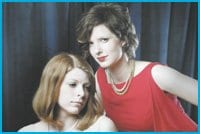Imagine being a gal looking for lesbian lit in 1950. There’s no Desert Of The Heart, no Rubyfruit Jungle. Everyone’s copy of The Well Of Loneliness is dog-eared. But what there is, thanks to Fawcett’s Gold Medal Books, is Women’s Barracks, “the frank autobiography of a French girl soldier.” The era of dyke-themed drugstore belles lettres had begun.
Lesbian Pulp Fiction: The Sexually Intrepid World Of Lesbian Paperback Novels 1950-1965 is an effective overview of the golden age of the genre. Editor Katherine V Forrest draws on numerous books and rounds up a range of plots – though there wasn’t much of a range to draw on.
Forrest is a San Francisco-based writer and editor whose resumé includes being the author of the Sapphic classic Curious Wine. She’s the winner of two Lambda Literary Awards and former senior editor at the now-defunct Naiad Press, which specialized in lesbian-themed work.
Her introduction neatly sums up the times: However sensational and tragic these books could be, Forrest argues, they were also the catalyst for lesbian liberation. Women read the books and found out they weren’t alone. They then found each other and the movement was born.
It is important to remember that when these stories were written homosexuality was a mental illness, if not a criminal offence. Censors were ever watchful for stories of happy homos, which is why words such as “trapped” and “forbidden” frequently graced jacket text.
Lesbian pulp was a success from the start. After Women’s Barracks, the Minnesota-based Fawcett Books began churning out more tales of woeful queer women and other publishers soon followed. Lesbian Pulp Fiction gathers excerpts from 22 of these books by 19 writers. Selections include The Girls In 3-B by Valerie Taylor, Beebo Brinker by Ann Bannon and Another Kind Of Love by Paula Christian.
These stories offer negative myths about lesbianism – lesbians are prostitutes, they have been damaged by their relationships with men, they live unstable lives with no possibility of long-term relationships. But there are also some positive portrayals – women escape Squaresville and discover the excitement of Greenwich Village bars, they have fabulous orgasms, they realize that it is society that is fucked up, not them, and, as one heroine states, they learn that you can’t get pregnant dancing with a woman.
Let’s face it, these aren’t the most well-written tales and even before you open them it’s obvious that they’re formulaic. Most covers depict two women (thin, coifed, white gals with cleavage thrust up to their chins) and invariably promise to give readers an exposé of this perverse subculture. This “frank study of forbidden love by twilight” angle is aided by the almost exclusive use of the third person.
The stories generally go something like this: girl meets girl, likely on campus or in a bar. One or both come to the realization that she is a lesbian. What happens next is either beyond tragic (“If Byrne had not interfered, Greta would be in New York, making a name for herself in the world of art, living a rich existence, full of the happiness of accomplishment”) or after-school special affirmative (“You’ve wasted years, suffering all alone, thinking you were some sort of horrible mistake. I want to show you that you’re not, that there are plenty of people like you, and a good majority of them leading ordinary, everyday, useful lives”). Perhaps worst of all, the sex scenes are also melodramatic: “Joan felt as if she had been thirsty for months and finally her mouth was being cooled by the refreshing sweetness of Kim’s, finally her burning body was being soothed.”
Anyone interested in this era might want to supplement Lesbian Pulp Fiction with a screening of Lynne Fernie’s doc Forbidden Love: The Unashamed Stories Of Lesbian Lives or a reading of Boots Of Leather, Slippers Of Gold: The History Of A Lesbian Community by Elizabeth Lapovsky Kennedy and Madeline D Davis for a richer retelling of the times. Although Forrest writes that it’s hard to find out what happened to some authors, it would have added more depth to have a brief introduction to each story, including information about the author and what she’s said about her work or more about the book’s history itself.
Nonetheless, the publication of this book, not to mention the republication of various individual classics in the last decade, demonstrate there’s a still a readership for lesbian pulp. Retro camp is surely a factor; Beebo Brinker is as much a sleazy, summertime read as Valley Of The Dolls. Moreover, the authors of these books didn’t just create cheap and tawdry tales; their words have real value. These books are more important for what they did for readers than what they said. Women found affirmation in their pages. As Forrest writes, they saved her life.

 Why you can trust Xtra
Why you can trust Xtra


